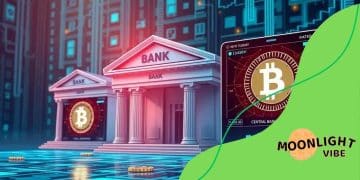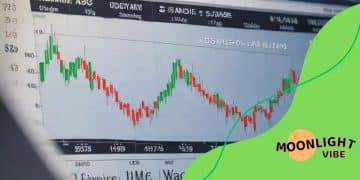Interest Rate Hike 2025: Impacts and Financial Strategies

Anúncios

An “Interest rate hike” may sound like just another financial term, but its impact reaches deep into your wallet.
Anúncios
Whether you’re managing a mortgage, planning investments, or saving for the future, changes in borrowing costs can shake up your entire financial strategy. In today’s economy, staying ahead of these fluctuations isn’t optional, it’s essential.
Let’s break down what every smart borrower and investor should know.
Understanding interest rate hikes
Understanding an interest rate hike is crucial for making well-informed financial decisions in a shifting economic environment.
These increases are implemented by central banks, such as the Federal Reserve, with the goal of influencing the cost of borrowing, consumer behavior, and overall market stability.
Anúncios
The effects are not confined to institutional finance; they reach deeply into everyday consumer decisions and investment outcomes.
What Leads to an Interest Rate Hike?
An interest rate hike happens when a central bank raises the benchmark rate that commercial banks use when lending to each other. This move is designed to influence broader economic conditions.
Typically, such hikes are used to manage inflation, prevent the economy from expanding too rapidly, and encourage healthier saving habits.
By raising rates, central banks make it more expensive to borrow money. This helps cool down excess consumer spending, reduce pressure on supply chains, and protect the long-term value of the national currency.
It is a balancing act that must be timed carefully to avoid either runaway inflation or an abrupt economic slowdown.
How Consumers Are Directly Affected
Consumers often feel the impact of an interest rate hike through increased borrowing costs. Monthly mortgage payments may rise, especially for those with variable-rate loans.
Credit card interest charges can also climb, making it more expensive to carry a balance from month to month. Auto loans and student loan repayments may also become more burdensome.
At the same time, savers can benefit. A higher interest rate environment typically leads to better yields on savings accounts and certificates of deposit.
This encourages a shift from borrowing and spending to saving and investing, altering household financial behavior.
How the Market Responds to Rate Hikes
Financial markets tend to react strongly to interest rate hikes. Higher rates can dampen corporate earnings by increasing borrowing costs and slowing consumer demand.
As a result, equity markets may experience periods of volatility or correction as investors reassess their positions.
On the other hand, sectors such as banking and insurance may benefit. These industries can see improved margins on lending and increased returns on reserve holdings.
Fixed-income investments like bonds can become less attractive in the short term, particularly those with longer durations, due to the inverse relationship between bond prices and interest rates.
Understanding the broader implications of an interest rate hike equips you to make more strategic financial decisions.
Whether you’re refinancing a loan, reallocating your portfolio, or considering a new investment, staying informed about central bank policy and economic trends allows you to respond with greater confidence.
Reasons behind current rate increases
To fully understand the ongoing cycle of interest rate hikes, it is essential to examine the underlying forces influencing central bank decisions.
These increases are not random or isolated but are typically driven by a combination of macroeconomic pressures, policy objectives, and financial stability concerns.
By exploring these factors, individuals can better anticipate future rate movements and prepare their personal and professional finances accordingly.
Strong Economic Expansion and Rising Demand
One of the most common triggers of an interest rate hike is a period of sustained economic growth. When the economy expands rapidly, consumer demand for goods and services tends to increase.
This surge in activity can lead to supply constraints, ultimately pushing prices upward. In response, central banks raise interest rates to reduce excess demand and maintain price stability.
As incomes grow and job markets strengthen, households are more likely to spend and borrow. Businesses, in turn, invest more to keep up with consumer needs.
While this cycle can stimulate progress, it also risks creating inflationary pressure if left unchecked. By increasing rates, policymakers seek to maintain balance between growth and sustainability.
Managing Inflation and Maintaining Purchasing Power
Persistent inflation is one of the most urgent reasons behind a central bank’s decision to implement an interest rate hike. When prices for essentials such as food, energy, and housing rise too quickly, the real value of money declines.
This reduces purchasing power and can undermine consumer confidence.
Raising interest rates makes borrowing more expensive and encourages saving, both of which help reduce the amount of money circulating in the economy.
This contraction in available credit slows spending, which can stabilize or even reduce prices over time. Monitoring inflation data is a key part of understanding why rates continue to rise in the current environment.
Federal Reserve’s Role in Policy Direction
The Federal Reserve plays a central role in shaping the course of interest rates through its monetary policy tools.
The most influential of these is the federal funds rate, which determines how much banks pay to borrow from one another. Adjusting this rate allows the Fed to directly influence liquidity and credit conditions in the market.
When economic indicators show signs of overheating, such as rapid job growth or surging inflation, the Federal Reserve may raise interest rates to prevent destabilization.
These moves are typically announced after scheduled meetings and often follow in-depth analyses of employment, inflation, and GDP data.
The Fed’s decisions carry broad consequences. Mortgage rates, credit card interest, business loans, and even savings yields are all impacted.
Staying informed about the Fed’s actions enables individuals and businesses to adapt their financial strategies in advance of changes.
Understanding the rationale behind an interest rate hike provides critical insight into how monetary policy functions. It also underscores the importance of staying alert to economic indicators and central bank communications that signal future adjustments.
How rate hikes affect borrowers

When an interest rate hike is announced, borrowers are among the first to feel the direct consequences.
Whether managing a mortgage, financing a car, or using credit cards, individuals who rely on borrowed money experience noticeable shifts in their monthly budgets and long-term financial planning.
These rate increases affect not only the cost of new loans but also the burden of existing debts, reshaping the way people approach credit and spending.
Monthly Loan Payments Become More Expensive
The most immediate and tangible impact of an interest rate hike is the rise in monthly loan payments. Borrowers with variable-rate loans, such as adjustable-rate mortgages, see their interest costs increase as rates adjust.
This can significantly strain household budgets, especially when the rate hikes are steep or frequent.
- Mortgage holders may face higher monthly installments, making it more difficult to meet housing expenses.
- Auto loan borrowers could see increased financing costs, particularly for longer-term loans.
- Student loans with variable rates may demand larger repayments over time, affecting young professionals entering the workforce.
- Credit card users often see the annual percentage rate (APR) rise, resulting in larger balances and greater interest accumulation for unpaid debts.
This increase in monthly obligations often requires borrowers to revisit their budgets, reduce discretionary spending, and reprioritize financial goals.
Borrowing Becomes Less Attractive for New Debts
As borrowing costs rise, individuals and businesses tend to delay or cancel plans to take on new debt. The cost-benefit ratio shifts, making loans for real estate, vehicles, and large consumer purchases less appealing.
In many cases, this leads to:
- Postponement of home purchases, especially for first-time buyers
- Reduced demand for car loans, particularly for non-essential or luxury vehicles
- Lowered consumer confidence, which can suppress retail and service sectors
- Hesitation among small businesses, as higher capital costs reduce profit margins
- This cautious behavior can ripple through the economy, contributing to slower growth and shifting lending patterns.
Long-Term Financial Planning
For those planning to borrow in the future, understanding the trajectory of interest rates can help in making better financial choices.
It’s wise to keep an eye on market trends and anticipate how they could affect personal finances and debt levels.
By being proactive, borrowers can navigate rate hikes more effectively and manage their financial stability, even as costs rise.
Influence on the housing market
The housing market is one of the sectors most directly and visibly impacted by an interest rate hike. As borrowing costs increase, both demand and affordability shift, influencing everything from buyer behavior to home values and construction trends.
Understanding how these changes ripple through the market is essential for buyers, sellers, and industry professionals alike.
Reduced Affordability and Slowing Demand
One of the most immediate consequences of an interest rate hike is reduced affordability. As mortgage rates increase, monthly payments grow, making it harder for individuals and families to qualify for home loans.
Even a small uptick in interest rates can add hundreds of dollars to a typical mortgage bill.
This change forces many buyers to reconsider their options. Some adjust their price expectations, opting for smaller or less centrally located homes.
Others choose to delay their purchase altogether, especially first-time buyers who are more sensitive to financial pressure.
As fewer people are able or willing to buy, the demand for housing decreases. Sellers may find it more difficult to receive offers at their asking prices, and properties tend to stay on the market longer.
In high-rate periods, home values often stabilize or grow at a much slower pace than during periods of low interest.
Shifting Buyer Behavior and Market Composition
Interest rate hikes also lead to noticeable changes in buyer preferences. Rather than stretching their budgets, buyers become more conservative.
Many begin looking for more affordable housing options, such as smaller properties or homes in areas with lower taxes and cost of living.
This shift affects the entire ecosystem of the housing market. Lower-priced homes may see more competition, while high-end properties remain unsold for longer periods.
Builders and developers also respond by focusing more on entry-level housing to meet demand from budget-conscious buyers.
The luxury segment, in contrast, tends to suffer in high-rate environments, as wealthier buyers often have more flexibility to wait for favorable conditions before making a purchase.
Long-Term Effects of Sustained Rate Hikes
When interest rates remain elevated over an extended period, the cumulative effect on the housing market becomes more pronounced.
Slower demand can dampen price appreciation, especially in overheated markets where values had previously surged ahead of income growth.
However, this cooling period can bring balance. If interest rate hikes succeed in taming inflation, the broader economy may benefit from greater price stability and increased consumer confidence in the long run.
Over time, a more measured housing market can help prevent speculative bubbles and improve overall accessibility.
For both buyers and sellers, keeping a close eye on the direction of each new interest rate hike is essential to making smart, timely decisions in a market that continues to evolve.
Investment strategies in a rising rate environment
In a climate shaped by frequent interest rate hikes, adopting the right investment strategies is essential to protect and grow your capital.
As borrowing costs rise and market dynamics shift, investors must rethink how and where they allocate their resources.
The key lies in understanding how various asset classes respond to changes in interest rates and how to adjust your portfolio to remain resilient.
Emphasizing Diversification and Resilience
A diversified portfolio becomes even more valuable during periods of monetary tightening. Different asset classes react uniquely to rising rates.
Stocks in companies with strong balance sheets and consistent earnings tend to perform better than speculative growth stocks, which are more vulnerable to economic slowdowns.
Bonds, especially long-duration ones, often lose value in this environment. However, short-term and floating-rate bonds can offer greater protection.
Real estate, while sensitive to borrowing costs, may remain attractive in regions with strong rental demand. Commodities like gold can serve as a hedge against inflation, preserving value when currency purchasing power declines.
By balancing exposure across these areas, investors can reduce portfolio volatility while maintaining growth potential.
Focusing on Defensive and Income-Generating Sectors
During an interest rate hike, certain sectors tend to outperform. Utilities and consumer staples, for example, continue to see steady demand even in times of economic uncertainty.
These industries offer products and services that people need regardless of broader financial conditions, making them more stable during volatile periods.
Investing in high-quality dividend-paying stocks can also provide consistent income. Companies with strong cash flows and healthy margins are better positioned to weather higher borrowing costs and market shifts.
Blue-chip stocks, in particular, may offer a combination of growth and reliability that is especially valuable when rates are elevated.
Rethinking Fixed-Income Strategies
Rising interest rates present a unique challenge for fixed-income investors. Since bond prices typically fall as rates increase, portfolios heavily weighted toward long-term bonds can suffer.
To adapt, many investors shift toward shorter maturities, which are less sensitive to rate changes and offer quicker reinvestment opportunities at higher yields.
Floating-rate bonds, whose interest payments adjust with market conditions, are also worth considering. Additionally, high-quality municipal bonds can offer tax advantages while delivering more stable returns in uncertain times.
Making these adjustments can help preserve capital and sustain income during aggressive rate cycles.
Staying Agile and Informed
Market conditions during an interest rate hike period evolve quickly. Staying updated on central bank policies, inflation trends, and macroeconomic indicators is essential for making timely investment decisions.
A flexible strategy allows you to pivot when needed and avoid emotional or reactionary responses to short-term market swings.
Regular portfolio reviews and a willingness to rebalance based on current conditions can significantly improve long-term outcomes.
Whether you’re a conservative saver or a growth-oriented investor, aligning your strategy with the realities of a high-rate environment is the most effective way to maintain financial momentum.
Preparing your investments for ongoing interest rate hikes isn’t just about protection—it’s about positioning yourself for opportunity in a more challenging financial landscape.
Preparing for future rate changes

Anticipating the next interest rate hike is not just a concern for economists or policy analysts—it’s a practical necessity for anyone aiming to protect their financial well-being.
As global economies continue to shift and central banks respond to inflationary pressures, being financially prepared for future rate increases can make a significant difference in your ability to stay secure and flexible.
Reading the Signals Behind Rate Movements
To anticipate future interest rate hikes, it’s important to stay alert to the economic indicators that often precede monetary policy changes.
Rising inflation is one of the clearest signs that rates may increase, as central banks raise borrowing costs to slow down excessive spending and bring prices under control.
Labor market data also plays a key role. When unemployment rates are low and job creation is strong, consumer spending tends to grow rapidly.
This heightened demand can lead to inflation, prompting central banks to respond with higher rates. Additionally, monitoring public statements and meeting minutes from institutions like the Federal Reserve provides valuable clues about upcoming policy shifts.
Understanding these signals helps individuals make more informed decisions about borrowing, investing, and saving.
Strengthening Your Financial Strategy
Each interest rate hike introduces new challenges to existing financial plans. Reviewing your strategy regularly can help you stay ahead of rising costs.
Begin by assessing your debt structure. If you carry variable-rate loans, consider refinancing into fixed-rate alternatives while rates are still manageable.
Adjusting your savings goals is also important. Building a cushion for increased loan payments, utility costs, or credit card interest can protect your monthly budget.
Refinancing mortgages or consolidating high-interest debts may also be worthwhile, particularly if you anticipate future rate hikes continuing in the months ahead.
A proactive approach to financial planning builds long-term resilience.
Building a Safety Net for Uncertain Conditions
An emergency fund remains one of the most valuable tools during periods of monetary tightening. As borrowing costs increase, having immediate access to cash can prevent you from relying on expensive credit during financial emergencies.
Aim to save at least three to six months of essential living expenses, depending on your personal situation.
This reserve not only protects you against unexpected rate-driven expenses but also allows you to take advantage of investment opportunities without overexposing your budget.
Keeping Your Investments Flexible and Strategic
Investment portfolios should evolve alongside economic conditions. In anticipation of further interest rate hikes, consider reducing exposure to assets that are highly sensitive to rate changes, such as long-term bonds or speculative growth stocks.
Instead, focus on sectors that have historically shown resilience in rising-rate environments.
Consumer staples, financial institutions, and utilities tend to maintain consistent performance when rates are high. These industries provide essential goods and services, which remain in demand regardless of borrowing conditions.
Flexibility is key. Regular portfolio reviews, strategic rebalancing, and attention to macroeconomic trends can help investors position themselves for both stability and growth as the rate environment shifts.
Staying prepared for the next interest rate hike means more than adjusting numbers on a spreadsheet, it requires a mindset of adaptability, awareness, and long-term thinking.
Final Thoughts: Mastering the Impact of Interest Rate Hikes
Navigating the financial landscape during an interest rate hike cycle requires more than reactive decisions, it demands strategic foresight.
Whether you’re a borrower facing increased loan payments, an investor rebalancing your portfolio, or a homeowner reconsidering mortgage terms, understanding how these rate changes affect each facet of your finances is vital.
The ripple effects of an interest rate hike go far beyond banking halls. They reshape housing markets, influence consumer spending, and redefine investment returns.
That’s why keeping a close eye on key economic indicators, like inflation and central bank policy, is essential for staying ahead of the curve.
If you’re unsure how a rising rate environment might affect your financial strategy, learning about the broader economic impact of interest rate hikes can offer valuable context.
According to Investopedia’s guide on the effects of rate increases, higher interest rates typically curb inflation, but also slow economic growth.
Similarly, Schwab outlines the sectors likely to win or lose in a high-rate environment, helping investors identify opportunities and manage risks accordingly.
Being proactive about future interest rate hike cycles means reassessing debt, strengthening emergency funds, and adapting your investments to fit the climate.
Whether you’re saving, spending, or investing, staying informed and flexible is the smartest way to protect your financial future.
As central banks continue adjusting policy, one thing is certain: the more prepared you are for the next interest rate hike, the better positioned you’ll be to thrive, no matter what the economy throws your way.
FAQ – Questions about Interest Rate Hikes and Financial Strategies
How can I prepare for future interest rate changes?
To prepare for future interest rate changes, monitor economic indicators, evaluate your budget, build an emergency fund, and stay flexible in your investment strategies.
What are some effective investment strategies during rising rates?
During rising rates, consider diversifying your portfolio, focusing on quality investments, and exploring short-duration bonds to mitigate risks.
How do interest rate hikes affect mortgage payments?
Interest rate hikes can increase mortgage payments, making homeownership less affordable and affecting how much buyers are willing to spend.
What economic indicators should I watch for changes in interest rates?
Important indicators include inflation rates, employment data, and announcements from central banks that can signal upcoming rate changes.





